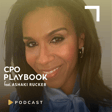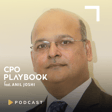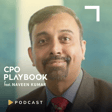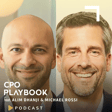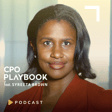Become a Creator today!Start creating today - Share your story with the world!
Start for free
00:00:00
00:00:01

Performance Management Best Practices with Felicia Shakiba
Curious about the secrets behind high-performance teams? Join Felicia Shakiba, your host, as she unveils her inspiring personal journey that led to the creation of the Four Pillars of Performance Management. In this episode, Felicia shares her innovative approach, offering a behind-the-scenes look at how these pillars were formulated through her real-world experiences. Discover invaluable insights tailored for leaders aiming to enhance organizational performance and take a fresh approach to leadership development. Whether you're focused on career growth or fine-tuning your management strategies, this episode is packed with practical wisdom to help you elevate your leadership game.
Transcript
Introduction to CPO Playbook Podcast
00:00:01
Speaker
I'm Felicia Shakiba, and this is CPO Playbook, where we solve a business challenge in every episode.
Critique of Performance Appraisals
00:00:14
Speaker
According to an article by Harvard Business Review, performance appraisals are seen as time-consuming, demotivating, inaccurate, biased and unfair. A McKinsey survey indicates most CEOs don't find the appraisal process in their companies helps to identify top performers, while over half of employees think their managers don't get the performance review right.
Felicia's Experience with Performance Management
00:00:38
Speaker
Normally, you'll find me interviewing incredible CEOs or insightful chief people officers. But not this week. Today, I'll be sharing my experience on how the four pillars of Performance Management Framework can ultimately have one of the greatest impacts on company culture. These four pillars are research-based, yet molded through decades of experience.
00:01:03
Speaker
My story begins when I was working with a global organization with about 100,000 employees and I found myself in the midst of this challenging task aiming to fuse the performance management strategies of its corporate headquarters with its diverse 13 subsidiaries or more.
00:01:22
Speaker
It was clear from the outset that the path forward to unify this strategy required an in-depth understanding of what worked and what didn't across these subsidiaries. This understanding was not solely derived from qualitative data gathering during my interviews with talent leaders, chief people officers, and focus groups, but it was also deeply informed by an article by McKinsey.
00:01:50
Speaker
specifically exploring the fairness factor in performance management. The first step I took was to explore the distinct ecosystems of each subsidiary. Conversations with leaders, discussions in focus groups, and interviews provided a nuanced view of the strengths and pain points of their existing performance management strategies.
00:02:10
Speaker
What emerged from this qualitative exploration were the fundamental components essential to any successful system. These components were not merely theoretical constructs, but practical pillars observed across the diverse subsidiaries and illuminated further by McKinsey's insights on fairness.
Key Pillars of Fair Performance Management Systems
00:02:31
Speaker
And why does fairness matter?
00:02:33
Speaker
Because if the strategy isn't fair, if the review isn't fair, employees will not respect the process. And if it's not valid or reliable, then why should it matter? So here is the McKinsey quote from their findings.
00:02:49
Speaker
The data also crystallized what a fair system looks like. Of course, a host of factors may affect employee perceptions on fairness, but three stood out. Our research suggests that performance management systems have a much better chance of being perceived as fair
00:03:07
Speaker
when they do these three things. One, transparently link employees' goals to business priorities and maintain a strong element of flexibility. Two, invest in the coaching skills of managers to help them become better arbiters of day-to-day fairness. And three, reward standout performance for some roles.
00:03:34
Speaker
while also managing converging performance for others. Such factors appear to be mutually reinforcing. Among companies that implemented all three, 84% of executives reported they had an effective performance management system. These respondents were 12 times more likely to report positive results than those who said their companies hadn't implemented any of the three."
00:04:03
Speaker
With this knowledge, immediately I knew I needed to craft a unified language that helped highlight these factors within the components of the Performance Management Strategy. It was about building bridges that connected the subsidiaries, ensuring everyone spoke the same dialect.
Goal Setting and Evolution of OKRs
00:04:24
Speaker
And so, the four pillars were born.
00:04:27
Speaker
The first is goal creation. Goal creation lies at the foundation of this strategy. It entails a collaborative process where objectives are co-created, fostering a culture of transparency and alignment throughout the organization, not just from top down, but also across.
00:04:49
Speaker
Embracing transparency ensures that every member understands their role in contributing to the overarching vision. Many organizations use the traditional KPIs, Key Performance Indicator, to set individual performance goals.
00:05:08
Speaker
However, if you are someone who isn't familiar with the term OKR, objectives and key results, this might be interesting. You see, when individuals create KPIs, what they're doing is they're identifying goals that they want to chase for themselves to hit their performance goals individually.
00:05:32
Speaker
However, this can potentially cause friction. It could be why finance doesn't always agree with HR, or product doesn't always agree with engineering.
00:05:46
Speaker
And it's because objectives might be missing. With OKRs, you're actually encouraging functions to work together to identify overarching objectives where their KPIs would complement, not compete against each other. And so, yeah, I'm a little biased when it comes to creating OKRs versus KPIs.
00:06:11
Speaker
Before moving to the second pillar, I want to share a short story of the evolution of goal management. The first strategy emerged from the wisdom of Peter Drucker in the 1950s. His Management by Objectives approach, also known as MBOs, became the cornerstone for companies striving to align their efforts with specific targets.
00:06:35
Speaker
As businesses sought structured methods, the 1980s saw the rise of the SMART criteria, Specific Measurable, Achievable, Relevant, Time-bound, S-M-A-R-T, becoming a guiding principle for goal-setting across industries. However, innovation sparked in the unlikeliest of places.
00:06:59
Speaker
Intel's corridors in the 1970s. Andrew Grove formulated a new concept, objectives, and key results, also known as OKRs. With a focus on ambition and clarity, OKRs gained traction within Intel before catching the attention of Czech behemoth Google in the 1990s.
00:07:22
Speaker
Google's adoption propelled OKRs into the limelight, showcasing their effectiveness in blending audacious objectives with measurable milestones. Soon, OKRs became more than a Silicon Valley trend. They became a go-to framework for goal-setting in various organizations worldwide. As time progressed, OKRs evolved alongside agile methods like Scrum and Kanban.
00:07:49
Speaker
They seamlessly integrated into these approaches, providing a structured, yet adaptable way to measure progress. And so, the story of OKRs isn't just about adoption, it's about adaptation.
Holistic Approach to Performance Evaluation
00:08:05
Speaker
Organizations can tailor OKRs to fit their unique cultures, adjusting the rhythm of goal-setting and expanding their use across teams.
00:08:14
Speaker
In essence, the history of goal management journeyed from MBOs, foundational principles, and the practicality of smart goals to the pragmatic and flexible framework of OKRs. Measurement The next pillar represents the vital framework by which the organization establishes the criteria for differentiating high, middle, and low performers.
00:08:37
Speaker
or perhaps on a wider scale. This discernment allows the organization to identify top achievers while also providing insights into individuals who may require additional support. However, many organizations might also recognize that some individuals might not fit neatly into predefined categories, opting for more holistic approaches to nurture every employee's growth and development.
00:09:06
Speaker
Now, I've seen organizations leverage three-point scales, five-point scales, and their bottom point could be two clicks below mid-performance, or it could sit in average, where the lowest performers sit in meeting expectations.
00:09:23
Speaker
Organizations who shy away from numerical values have also potentially implemented ordinal values, and I'm not sure that makes a difference in the measurements, but I might argue it makes a difference in the perceived fairness of the measurement.
00:09:40
Speaker
Imagine being told you're a 3 versus being told you're meeting expectations. Now, what do we measure? In many organizations, performance evaluation primarily revolves around achieving set goals.
00:09:57
Speaker
potentially overlooking vital aspects of an individual's overall contribution. However, this strategy of only measuring goals will almost always ensure cultural destruction. A more comprehensive approach to measuring overall performance involves a three-pronged strategy.
00:10:19
Speaker
allocating a third of the assessment to goals, another third to competencies aligned with the individual's role that might include level and function, and the remaining third to cultural values. While goals are crucial markers of productivity, competencies encompass a broader range of skills and abilities, reflecting how effectively tasks are executed,
00:10:47
Speaker
Then, evaluating based on cultural values acknowledges behaviors fostering a work environment that you as an executive want to encourage for your business. This approach is critical because it encourages a well-wounded performance, recognizes diverse contributions beyond quantitative goals, supports holistic employee development, and drives a positive organizational culture.
00:11:15
Speaker
Executives play a pivotal role in advocating for and implementing this approach, shaping a culture where performance is assessed comprehensively, nurturing not only goal attainment, but also competencies and cultural alignment.
00:11:34
Speaker
The irony that often amuses me is when executive teams enthusiastically adopt a strategy like this for their businesses and for their employees, but overlook holding themselves accountable to the full scope of measurement, which is the most critical component if they want the strategy to work completely.
00:11:58
Speaker
The linchpin for making this strategy truly effective lies in you as the executive team member to actively participate and commit to embodying the competencies and values integral to the entire measurement process.
Effective Performance Management Dialogues
00:12:14
Speaker
Conversations, the third pillar, is the heartbeat of performance management, pulsating with ongoing, impactful dialogues between managers and their teams. A lot of times I'll talk to managers and they'll say, I meet with my teams every day. We talk every day. But a performance conversation, a weekly conversation, such as where are you on your progress and how can I help?
00:12:41
Speaker
These discussions serve as a platform for exchanging valuable feedback, addressing the challenges, and recognizing achievements. These exchanges promote the collaborative environment that you need to build trust throughout the business between leaders and their teams, which in turn ignites the potential of each team member.
00:13:02
Speaker
And this is very much an L and D or learning and development piece for managers where managers can be taught how to not just give feedback, but how to be arbiters of day to day fairness. Now I want to come back to this concept of growing managers to become arbiters of fairness, but first there are four conversations that lock into this third pillar of performance management.
00:13:30
Speaker
The one-on-one, the career conversation, the courageous conversation, and the rewards conversation. The one-on-one is a weekly or bi-monthly conversation between you and your team member. There are a few structures you can create with this, but overall it should be anywhere from 30 minutes to an hour depending on the frequency and level. This can change and can be unique to your function or organization
00:14:00
Speaker
but overall it's consistent and it's private. The main points of this conversation is to keep each other updated, show recognition and appreciation, adjust priorities, and unblock your team members.
00:14:16
Speaker
The career conversation I'd recommend having once every quarter to discuss your team members career development, new skills they've learned or need to learn, connect with mentors, training to attend and ensuring that they're on track.
00:14:36
Speaker
The courageous conversation is as needed. This might be with team members who need immediate feedback on how to realign their actions, behaviors, or tasks. It's a conversation many managers like to avoid and then have to have heavier discussions later on because they didn't have this one first.
00:14:59
Speaker
The important note here is to be specific on what the incident is and shy away from general characterizations like you're always late and replace it with you were 20 minutes late to work yesterday.
00:15:17
Speaker
And finally, the rewards conversation. At the end of the day, the organization should have specific guidelines for rewards and recognition. And this conversation should be had to ensure transparency and accountability.
00:15:33
Speaker
And this discussion should absolutely occur once or twice a year. Now, circling back to building managers to become arbiters of day-to-day fairness, how do we as the organization do that?
00:15:50
Speaker
How do we teach managers to be fair in their performance and managerial day-to-day conversations with their teams? Number one, avoid favoritism. Encourage managers to consciously treat all team members equally by emphasizing the importance of fair treatment and assignments, recognition, and opportunities for growth, ensuring that decisions are merit-based.
00:16:17
Speaker
Too often I see favoritism with stay power employees. I think executive teams should ask themselves, do I want to promote loyalty or performance? Now, both are important. There's no doubt. And many times the most loyal employees are the better performers, but there might come a time when that's not the case. And so you need to ask yourself, what kind of culture do I want to build?
00:16:49
Speaker
Number two, bias-free communication. Train managers to communicate without bias. Provide guidance on using inclusive language and avoid stereotypes or assumptions when interacting with team members. Encourage them to be mindful of their language. A leader I was working with once during team meetings
00:17:14
Speaker
She would habitually interrupt and dismiss ideas presented by certain team members while giving significant validation to suggestions from a select few. This communication style resulted in team members feeling marginalized and discouraged from contributing their viewpoints. And if team members don't feel that they're being treated fairly in basic team meetings, they're likely not going to trust the quarterly or biannual performance assessment.
00:17:43
Speaker
Number three is inclusivity in decision making. Emphasize the value of diversity of thought and perspectives and ideas. As we learned in episode three from Dr. Todd Cashton, fostering an inclusive environment where everyone's input is valued doesn't just create a perception of managerial fairness, but also fosters a great degree of creativity and innovation
00:18:12
Speaker
Ensuring people feel heard and seen, even during unpopular suggestions, directly impacts the perception of fairness. And finally, number four, create equal opportunities. Managers must provide equal opportunities for professional development, growth,
00:18:33
Speaker
and career advancement to all team members. Encourage them to create pathways for advancement based on skills, performance, and potential rather than personal preferences.
Acknowledging High Performers and Cultural Alignment
00:18:46
Speaker
By helping managers focus on these tangible actions during daily conversations and avoiding favoritism, unbiased communication,
00:18:56
Speaker
Inclusivity in decision-making and equal opportunities, leaders can effectively serve as arbiters of day-to-day fairness, fostering an environment where all employees feel valued and respected. Finally, rewards and recognition form the bridge between individual, team, and organizational performance and the acknowledgement and incentives they receive.
00:19:21
Speaker
High performers who consistently contribute to the organization's success rightfully deserve greater recognition and rewards as an expression of appreciation and motivation. This approach cultivates a sense of fulfillment and loyalty among employees, which bolster their commitment to excellence. If you don't do this, then a lot of what's in it for me will be asked.
00:19:50
Speaker
and ultimately won't be perceived as fair. What is the goal of performance management?
00:19:57
Speaker
Performance management is not a punitive or one-sided process aimed solely at employee evaluation or disciplinary actions. It should not be approached as a mechanism to micromanage employees or as a method to solely rank and rate individuals against each other. That's a vast track way to create a competitiveness rather than a collaborative culture.
00:20:25
Speaker
Performance management should also not be a one-time event restricted to annual performance reviews. Instead, it should be ongoing, collaborative, and a supportive process that fosters continuous growth and development, which ultimately is the fastest way to encourage employees to perform at their best. And so what is performance management designed to do?
00:20:51
Speaker
Well, the primary goal is to enhance individual and organizational performance to achieve strategic objectives. It aims to align the efforts of employees with the broader goals of the organization, ensuring that everyone's work contributes to the overall success of the company.
Implementing Change in Performance Strategies
00:21:13
Speaker
So naturally, the next question is how do you implement a performance strategy like this? Well, implementing any type of strategy in an organization takes great change management skills.
00:21:29
Speaker
Start by identifying key stakeholders, including employees, managers, HR personnel, ensuring that they're going to stay engaged throughout the process. That might be in the form of a steering committee. And if it is, make sure you have diverse representation. Communicate the strategy's purpose clearly. This shouldn't be done in the dark or behind the scenes.
00:21:55
Speaker
Emphasizing its alignment with the organizational goals and its benefits for individual growth and company objectives will go a long way. Gain the support from top leadership to set an example and establish commitment.
00:22:11
Speaker
If your CEO is not on board, it's not going to work. We can leverage so many strategies and be the best at what we do. But unless your executive team is fully bought in, you're not likely going to budge company culture or the process. So make sure you gain support and establish commitment first.
00:22:34
Speaker
Then you can start providing training for managers to proficiently handle goal setting, feedback, performance evaluations, feedback with diverse sensitivity. Equally important is educating employees on crafting OKRs, or perhaps you're using smart goals.
00:22:56
Speaker
It's really up to the organization and what it can handle and really what it's ready for. Readiness is important. Meeting people where they're at is important. If you run, they won't catch up to you. You're going to have to walk with them.
00:23:14
Speaker
introduce the strategy gradually, testing it in specific departments to identify those challenges and gather feedback for refinement before fully implementing the strategy. This is crucial. If everyone's on board and you completely change the strategy without testing and without piloting, it's likely all of those challenges are going to come at you at once from different departments.
00:23:42
Speaker
Then, establish continuous feedback channels for stakeholders to express concerns and suggestions, informing strategic adjustments for better efficacy. One thing to note is that if you're looking to lead this implementation and expecting no concerns, you're probably going to be unsuccessful. And that's the truth. Change management is challenging. It's tough.
00:24:09
Speaker
You have to be able to anticipate the feedback and empathize with those who don't agree with you. And only then will you be able to build your trust, build credibility, and change minds and be persuasive. There's an amazing episode on building trust with Juliette Huck. It's just a couple episodes back. And if you're being challenged with building trust in your organization, you can start there.
00:24:37
Speaker
Moving forward, regularly monitoring progress using relevant performance indicators and adapt the strategy as needed for optimal performance. You're not just testing whether or not it works based on concerns that are lifted.
00:24:55
Speaker
You're also looking for quantitative data to see if the strategy is working or not. And so make sure you and your stakeholders agree on what efficiency and effectiveness in a strategy look like. Then recognize and celebrate those achievements that result from the strategy's implementation.
00:25:17
Speaker
to boost morale and reinforce its value. This is an important step often forgotten. It's important to pause and recognize what you've accomplished with your team throughout the process. Finally, you can integrate the strategy into the organizational culture to ensure
00:25:35
Speaker
sustained alignment with the company values. I can't emphasize this enough that values should be implemented alongside the quantitative goal-setting creation.
00:25:50
Speaker
If you take this big picture of understanding how performance is truly evaluated, it's not just about hitting goals. It's about how you treat others in the organization and how you live and breathe the values of the business. And finally,
00:26:10
Speaker
That is the biggest takeaway. Performance management again isn't just about understanding an individual's performance. It's about how functions come together to create and live their values, collaborate with each other in order to achieve
00:26:29
Speaker
organizational goals, and it's about understanding where you are in order for you to grow in your career based on the competencies that are expected in the role. And only then will you have a true, valid, and reliable understanding that's fair where you can look at where you're at today, where you're going, and how to get there.
00:26:56
Speaker
The journey toward a unified performance management strategy wasn't just about data points or theoretical concepts. It was about distilling insights from real-world scenarios, marrying them with expert knowledge and crafting a framework that resonated across diverse landscapes.
00:27:16
Speaker
By embracing these core components and fostering this shared language, the organization will embark on a path toward a cohesive and effective performance management strategy.
Conclusion and Call to Action
00:27:32
Speaker
Thank you all for listening. If you're looking to reinvent your performance management strategy or have questions, please visit cpoplaybook.com. This is your host, Felicia Shakiba. Happy New Year.
00:27:48
Speaker
If today's episode captured your interest, please consider sharing it with a friend or visit cpoplaybook.com to read the episode or learn more about leadership and talent management. We greatly appreciate your rating, review, and support as a subscriber. I'm Felicia Shakiba. See you next Wednesday and thanks for listening.


